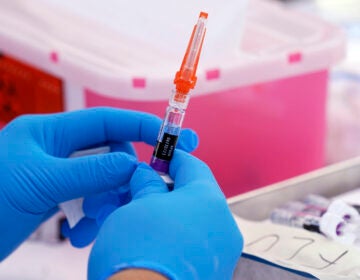More than 1 million Americans were diagnosed with COVID over the long holiday weekend

People line up to get tested for COVID-19 at a testing site in Washington, D.C., on Wednesday. More than 1 million Americans tested positive for COVID-19 on Monday, according to data from Johns Hopkins University. (Eva Hambach/AFP via Getty Images)
The U.S. reported a record 1,082,549 new COVID-19 cases on Monday, according to data from Johns Hopkins University. It’s the latest in a series of staggering milestones brought on by the highly transmissible omicron variant, which is sweeping across the U.S. and around the world.
The U.S. has broken several of its own COVID-19 records in recent days. Last week Johns Hopkins reported more than 480,000 new cases in a single day, more than double the number of daily cases reported during the peak of the delta surge. The seven-day average topped 280,000.
For reference: The country was averaging about 70,000 cases a day in early November.
Monday’s rise could be due to delays in reporting over the holidays, and probably includes tests conducted over the weekend. The 7-day daily average for infections is currently at 480,273 per day.
The milestone is more than twice the case count seen anywhere else in the world since the start of the pandemic, according to Bloomberg, which says the highest number outside of the U.S. was when more than 414,00 people were diagnosed on a single day in May during India’s delta surge.
As public health experts have noted, the numbers we’re seeing could also be a undercount. With so many people testing themselves at home, it’s hard to capture the true number of cases, as Centers for Disease Control and Prevention Director Dr. Rochelle Walensky told NPR last week.
Experts also caution about putting too much stock solely in case counts, focusing instead on metrics like hospitalizations and deaths, which reflect the severity of illness. Those numbers are also rising, but not at nearly the same rate.
Experts say the number of hospitalizations is more relevant than overall cases
Still, the number of hospitalizations is noteworthy.
Currently, 112,941 Americans are hospitalized with COVID-19, and 26% of ICU beds are occupied by COVID-19 patients.
Only two other times during the pandemic have hospitalizations surpassed 100,000 in the U.S. The first time was a year ago — when hospitalizations exceeded 120,000. And the second time was this past summer, when the delta variant hit.
And Johns Hopkins counted 1,688 new deaths on Monday, down from a record 4,442 last January — before COVID-19 vaccines were widely available.
Even with fewer people getting really sick, hospitals are still strained
NPR’s Michaeleen Doucleff explained that the perceived lesser severity of omicron — compared to delta — might actually be because it’s infecting a large number of vaccinated people, who are less likely to get really sick (even two shots protect people from getting sick enough to be hospitalized by 70%).
She spoke with Dr. Roby Bhattacharyya, an infectious disease doctor at Massachusetts General Hospital, who cited data suggesting that omicron may be just as severe as previous variants in unvaccinated people, while spreading faster — which could lead to a sharp increase in hospitalizations.
Dr. Anthony Fauci, the nation’s top infectious disease expert, told ABC News’ “This Week” on Sunday that the country is seeing “almost a vertical increase” in cases, and that even a relatively lower rate of hospitalizations could strain already overwhelmed hospitals.
“We have got to be careful about that, because, even if you have a less of a percentage of severity, when you have multi-multi-multi-fold more people getting infected, the net amount is you’re still going to get a lot of people that are going to be needing hospitalization,” Fauci explained. “And that’s the reason why we’re concerned about stressing and straining the hospital system.”
Plus, skyrocketing cases are disrupting all kinds of plans and industries
Dr. Natalie Dean, an assistant professor of biostatistics at Emory University, made a similar case on NPR’s All Things Considered on Monday.
“The public health impact is made up a lot of different things, and we’re most acutely interested in severe disease and death,” she said. “But, of course, infections have impacts and we think about the disruption — all the people who are going to need to miss work, including health care professionals and frontline workers. So the numbers have meaning, but it is a different public health impact when someone is mildly ill or doesn’t even have symptoms than when someone is severely ill.”
The skyrocketing case count has snarled holiday plans, disrupted travel and thrown another wrench into returns to schools and workplaces. The CDC has since altered its guidance to recommend COVID-positive people isolate for five days instead of 10 if they’re no longer showing symptoms, and is reportedly considering adding a negative test to that recommendation.
The CDC now estimates that 95.4% of coronavirus cases are due to the omicron variant, based on data for the week ending Saturday.
“Just seeing the transmissibility of delta was remarkable already, but this is just even beyond that,” Dean added. “So I think that’s something that’s hard to wrap our heads around. Just how many people are likely to be infected over the next month is just going to be a lot of disruption, unfortunately.”
The update brings cumulative U.S. infections for the entire pandemic to 56,189,547, the most of any country.
A version of this story originally appeared in the Morning Edition live blog.
9(MDAzMzI1ODY3MDEyMzkzOTE3NjIxNDg3MQ001))


![CoronavirusPandemic_1024x512[1]](https://whyy.org/wp-content/uploads/2020/03/CoronavirusPandemic_1024x5121-300x150.jpg)


